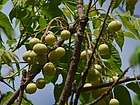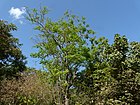Note: This is a project under development. The articles on this wiki are just being initiated and broadly incomplete. You can Help creating new pages.
Difference between revisions of "Garuga pinnata"
| Line 3: | Line 3: | ||
==Uses== | ==Uses== | ||
{{Uses|}}, {{Uses|}}, {{Uses|}}, {{Uses|}}, {{Uses|}}, {{Uses|}}, {{Uses|}}, {{Uses|}}, {{Uses|}}, {{Uses|}}, {{Uses|}}.<ref name="Uses"/> | {{Uses|}}, {{Uses|}}, {{Uses|}}, {{Uses|}}, {{Uses|}}, {{Uses|}}, {{Uses|}}, {{Uses|}}, {{Uses|}}, {{Uses|}}, {{Uses|}}.<ref name="Uses"/> | ||
| + | |||
| + | ===Food=== | ||
| + | Garuga pinnata can be used in Food. Mature fruits are eaten raw, cooked as a vegetable and pickled. They are acidic in taste. | ||
==Parts Used== | ==Parts Used== | ||
| Line 27: | Line 30: | ||
===Prabhava=== | ===Prabhava=== | ||
| + | |||
| + | ===Nutritional components=== | ||
| + | Garuga pinnata Contains the Following nutritional components like - Vitamin-C and E, Quercetin, Folic acid; Calcium, Iron, Magnesium Potassium, Phosphorus, Sodium<ref name="Nutritional components"/> | ||
==Habit== | ==Habit== | ||
| Line 50: | Line 56: | ||
{{Propagation|Seeds}}, {{Propagation|Cuttings of roots}}. | {{Propagation|Seeds}}, {{Propagation|Cuttings of roots}}. | ||
| − | == | + | ==Cultivation Details== |
| − | A plant of the moist tropics, where it is found at elevations from 400 - 1,200 metres.<ref name="How to plant/cultivate"/> | + | A plant of the moist tropics, where it is found at elevations from 400 - 1,200 metres. Garuga pinnata is available through February to August<ref name="How to plant/cultivate"/> |
==Commonly seen growing in areas== | ==Commonly seen growing in areas== | ||
| Line 66: | Line 72: | ||
==References== | ==References== | ||
<references> | <references> | ||
| − | |||
<ref name="chemical composition">[Chemistry]</ref> | <ref name="chemical composition">[Chemistry]</ref> | ||
| − | |||
<ref name="Leaf">[Morphology]</ref> | <ref name="Leaf">[Morphology]</ref> | ||
| − | |||
<ref name="How to plant/cultivate">[http://tropical.theferns.info/viewtropical.php?id=Garuga+pinnata Cultivation]</ref> | <ref name="How to plant/cultivate">[http://tropical.theferns.info/viewtropical.php?id=Garuga+pinnata Cultivation]</ref> | ||
<ref name="Uses">Indian Medicinal Plants by C.P.Khare</ref> | <ref name="Uses">Indian Medicinal Plants by C.P.Khare</ref> | ||
| + | <ref name="Nutritional components">Forest food for Northern region of western ghat pdf by Dr. Mandar N. Datar and Dr. Anuradha S. Upadhye, MACS - Agharkar Research Institute, Pune</ref> | ||
</references> | </references> | ||
Revision as of 11:23, 21 October 2021
Garuga is a deciduous tree growing up to 18 metres tall, with bark pealing off in flakes. The tree is cultivated in home gardens in India for its edible fruit and also as a support for Piper nigrum.
Contents
- 1 Uses
- 2 Parts Used
- 3 Chemical Composition
- 4 Common names
- 5 Properties
- 6 Habit
- 7 Identification
- 8 List of Ayurvedic medicine in which the herb is used
- 9 Where to get the saplings
- 10 Mode of Propagation
- 11 Cultivation Details
- 12 Commonly seen growing in areas
- 13 Photo Gallery
- 14 References
- 15 External Links
Uses
[[:Category:Ayurvedic Herbs known to be helpful to treat |]], [[:Category:Ayurvedic Herbs known to be helpful to treat |]], [[:Category:Ayurvedic Herbs known to be helpful to treat |]], [[:Category:Ayurvedic Herbs known to be helpful to treat |]], [[:Category:Ayurvedic Herbs known to be helpful to treat |]], [[:Category:Ayurvedic Herbs known to be helpful to treat |]], [[:Category:Ayurvedic Herbs known to be helpful to treat |]], [[:Category:Ayurvedic Herbs known to be helpful to treat |]], [[:Category:Ayurvedic Herbs known to be helpful to treat |]], [[:Category:Ayurvedic Herbs known to be helpful to treat |]], [[:Category:Ayurvedic Herbs known to be helpful to treat |]].[1]
Food
Garuga pinnata can be used in Food. Mature fruits are eaten raw, cooked as a vegetable and pickled. They are acidic in taste.
Parts Used
Chemical Composition
Common names
| Language | Common name |
|---|---|
| Kannada | Aranelli |
| Hindi | Kharpat |
| Malayalam | Annakaara |
| Tamil | Arunelli |
| Telugu | Garuga |
| Marathi | Kakad |
| Gujarathi | Kaked |
| Punjabi | |
| Kashmiri | |
| Sanskrit | Karnikarha |
| English | Garuga, Grey downy balsam |
Properties
Reference: Dravya - Substance, Rasa - Taste, Guna - Qualities, Veerya - Potency, Vipaka - Post-digesion effect, Karma - Pharmacological activity, Prabhava - Therepeutics.
Dravya
Rasa
Guna
Veerya
Vipaka
Karma
Prabhava
Nutritional components
Garuga pinnata Contains the Following nutritional components like - Vitamin-C and E, Quercetin, Folic acid; Calcium, Iron, Magnesium Potassium, Phosphorus, Sodium[3]
Habit
Identification
Leaf
| Kind | Shape | Feature |
|---|---|---|
Flower
| Type | Size | Color and composition | Stamen | More information |
|---|---|---|---|---|
| {{{5}}} |
Fruit
| Type | Size | Mass | Appearance | Seeds | More information |
|---|---|---|---|---|---|
Other features
List of Ayurvedic medicine in which the herb is used
Where to get the saplings
Mode of Propagation
Cultivation Details
A plant of the moist tropics, where it is found at elevations from 400 - 1,200 metres. Garuga pinnata is available through February to August[5]
Commonly seen growing in areas
Mixed forests, Sparse mountain forests, Valley scrub.
Photo Gallery
References
External Links
- Ayurvedic Herbs known to be helpful to treat
- Herbs with Fruits used in medicine
- Herbs with common name in Kannada
- Herbs with common name in Hindi
- Herbs with common name in Malayalam
- Herbs with common name in Tamil
- Herbs with common name in Telugu
- Herbs with common name in Marathi
- Herbs with common name in Gujarathi
- Herbs with common name in Sanskrit
- Herbs with common name in English
- Habit - Deciduous tree
- Index of Plants which can be propagated by Seeds
- Index of Plants which can be propagated by Cuttings of roots
- Herbs that are commonly seen in the region of Mixed forests
- Herbs that are commonly seen in the region of Sparse mountain forests
- Herbs that are commonly seen in the region of Valley scrub
- Herbs
- Pages without herbs images




